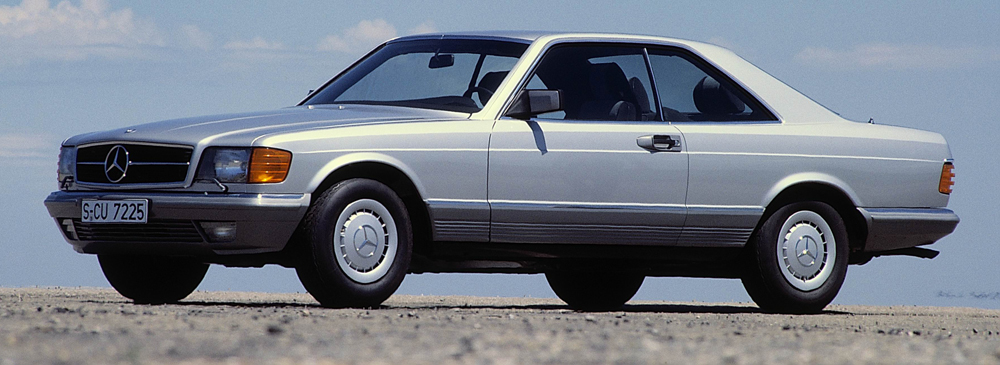
The CL-Class
C 126 series (1981 to 1991) — S-Class as Coupé: “By tradition, Mercedes-Benz has always been building a special type of car which is distinguished from other models series by its high level of individuality: the Coupé.” These were the introductory words in the brand’s brochure about the Coupés from the C 126 series. “The Mercedes Coupé embodies the rare type of a refined and sporty automobile. Its sporty character does not mean that the car has to do without comfort and safety. On the contrary, its sporty attributes combine with all those qualities which distinguish every Mercedes. The new Coupé is a car in which you can cover part of your path of life in the most sophisticated style.”
At the Frankfurt International Motor Show in September 1981, Daimler-Benz presented the 380 SEC and 500 SEC Coupés. The new generation of Coupés was again based on the S-Class Saloon rather than an SL as in the case of the SLC models. A six-cylinder-engined version analogous to the 280 SLC was no longer available. The V8 engines – already introduced in the Saloon and SLC models – had been thoroughly revised as part of the “Mercedes-Benz Energy Concept” with the aim of reducing both fuel consumption and pollutant emissions.
The list of improvements included a rise in the compression ratio, camshafts with modified valve timing, air-bathed injection valves and electronic idle speed control. Due to the modified camshaft tuning, the maximum torque was now reached at lower engine speeds and, in the case of the 3.8-litre engine, even raised. The latter engine had been modified particularly thoroughly: to achieve a more favourable volume-to-surface ratio, the bore had been reduced and the stroke increased. As a result, the modified 3.8-litre V8 had a slightly larger displacement. In the case of both eight-cylinder engines, substantially improved economy was achieved at the expense of slight reductions in performance. The rear axle ratio was adapted to the changed characteristics of both engines. The sum-total of all modifications clearly reduced the fuel consumption of the SEC Coupés as compared to their predecessor models.
Sophisticated suspension for enhanced comfort and safety
With the exception of detail modifications, the suspension was identical with the basic Saloons. Like the latter, the Coupés were equipped with a double-wishbone front axle and a semi-trailing arm rear axle with anti-squat control. For the first time, the SEC Coupés featured floating-calliper disc brakes on the front wheels, permitting the use of larger brake discs as well as the location of the brake cylinders on the inside of the wheels where they were cooled more effectively.
The frame/floor unit was also taken from the Saloon, albeit shortened by 85 millimetres. The wheelbase was thus 30 millimetres longer than on the predecessor series and the passenger compartment appreciably more spacious. The bodywork was designed on the basis of the latest findings in safety research – supported by expedient measures which had already been applied in the Saloons: to compensate for the non-existing central pillars, the roof frame structure was improved and the A-pillars were strengthened with welded-in high-strength tubing. As a result, the Coupés lived up to the same high safety standard as the S-Class Saloons. An interesting equipment detail were the electrically operated belt feeders which formed part of the standard specifications of the SEC models and had the task of moving the seat belt into the field of vision and thus within easy reach of the driver and front passenger. In addition, an airbag for the driver and a belt tensioner for the front passenger were optionally available.
The styling of the new Coupés was equally modelled on that of the four-door models but still included the horizontal radiator grill typical of the SL – a relic from the SLC era in a way. The decidedly elegant and harmonious styling met with highly positive response right from the start: the SEC Coupé was one of the most beautiful cars of the post-war time. The two bumpers and the protective side strips were designed in the same way as on the Saloons; the front apron reached further down and accommodated the fog lamps. A remarkable design detail was the aerodynamically optimized door handle recess which largely prevented the door handle from soiling. In any case the vehicle’s aerodynamics were optimised as a whole for lower fuel consumption. This left the drag coefficient for all models of cd=0.34. The only exception to this was the 560 SEC model, where the value was cd=0.35 on account of its wider tyres.
Discreet facelift and new engines
Four years after the presentation of the SEC Coupés, both the S-Class Saloons and the Coupés were extensively refined and introduced at the Frankfurt International Motor Show in September 1985. Apart from a discreet retouching of the exterior – primarily of the bumpers, the protective side strips and the wheels – the engine range was restructured.
A new engine in the range was a V8 with a displacement of 4.2 litres, created by drilling out the 3.8-litre unit and replacing the latter not only in the SEC Coupé but also in the S-Class Saloon and in the SL. The five-litre engine was equally modified and equipped with electronic ignition and an electronically/mechanically controlled KE-Jetronic injection system from Bosch to develop an output of 180 kW.
The most spectacular novelty in the engine range was a 5.6-litre eight-cylinder which had been developed from the five-litre V8 whose stroke had been lengthened to give the car an output of 200 kW. A version with an even higher compression ratio was optionally available and generated a proud 221 kW, but could not be combined with a closed-loop emission control system. However, even without a catalytic converter, this so-called ECE version complied with the emission limits specified by the European Economic Commission (ECE). At the time of their launch, the 560 SEC and 560 SEL with this engine were the most powerful Mercedes-Benz production cars built until then.
Catalytic converter optionally available
For all variants of the revised engine range – with the exception of the ECE versions of the 560 SEC and 560 SEL models – a closed-loop emission control system with three-way catalytic converter was optionally available. The standard version was prepared for the retrofitting of a catalytic converter, meaning that the car was supplied without a catalytic converter and oxygen sensor but with a multi-functional mixture formation and ignition system. A closed-loop catalytic converter could be retrofitted at any time and without a problem. This solution gave the customer the greatest possible flexibility in determining the point in time for the conversion – a major advantage in view of the fact that unleaded fuel was not yet available throughout Europe. From September 1986, the closed-loop catalytic converter formed part of the standard specifications of all
Mercedes-Benz passenger cars with gasoline engines; the versions for retrofitting remained optionally available until August 1989 – at a correspondingly reduced price.
The chassis of the refined models had not been modified to any major extent. However, the rear-axle design had been modified in several details in order to improve ride comfort and the smooth running characteristics still further. Apart from that, all Coupés and Saloons from the 126 series were now equipped with 38.1 cm wheels and correspondingly larger brakes. The styling of the optionally available light-alloy wheels, which were standard only on the 560 SEC and 560 SEL, was updated and adapted to that on the compact and mid-sized series.
Functional design
The remaining stylistic modifications on the improved models of the 126 series were made not only for the purpose of updating the design but also for substantial technical reasons. With front aprons extending far downwards, lift forces were further reduced, and the air outflow at the rear improved. It was thus possible to increase road-holding stability at high speeds still further – an aspect that was significant especially in view of the performance of the new 560 SEC and 560 SEL top models.
The protective side strips were smooth-surfaced now rather than being ribbed as before; like the bumpers, they extended further downwards and featured additional frame side member cladding. As the 5.6-litre models differed from their less powerful sister models in that they were fitted as standard with wide tires in size 215/65 VR 15, the front apron and the fender beading were modified in their shape to ensure the required lateral clearance for the front wheels.
In September 1987, more powerful versions of all V8 engines were introduced. The compression ratio of all units was raised to 1:10, and additional measures were taken to boost the output by six to ten percent, depending on the model. The boosting effect was even more substantial for the engines with catalytic converters; by optimizing the emission control system, the engineers had succeeded in significantly reducing the losses in output caused by the catalytic converter. The ECE version of the 5.6-litre V8 was omitted after the retrofitting variant had been upgraded to generate 221 kW.
In September/October 1991, almost ten years after the market launch of the SEC Coupés, production was discontinued. The total volume of 74,060 units built gives an impression of the model family’s high popularity. Clearly the rarest version was the 420 SEC with just 3,680 units.
History: the CL-Class from Mercedes-Benz and its predecessors
The real story of the CL-Class and its direct predecessors goes back to the 1950s. For completeness’ sake, the list is headed by a car which, as a special version of the representational 300 Saloon, did not belong to this group of CL-Class forbears in the narrowest sense. Nevertheless, the 300 S Coupé and 300 Sc Coupé are worthy of mention here since they made the same claim to style and exclusivity as the later CL-Class. Similarly, the SLC Coupés from the C 107 series have a place in this family history of the current CL-Class, even though these models, built from 1971 to 1981, were based on the SL touring sports car of the R 107 series.
What unites all these coupés, in addition to their styling, is the fact that they always have the latest automotive engineering on board and are thus ahead of other cars. Because many technical innovations often make their debut both in S-Class Saloons and Coupés before being widely used in other models.
- 300 S Coupé, 300 Sc Coupé (W 188 series, 1952 to 1958)
- 220 Coupé (W 187 series, 1953 to 1955)
- 220 S Coupé, 220 SE Coupé (W 180 series/W 128 series, 1956 to 1960)
- 220 SEb Coupé, 250 SE Coupé, 300 SE Coupé, 280 SE Coupé, 280 SE 3.5 Coupé (W 111 series/W 112 series, 1961 to 1971)
- 280 SLC, 350 SLC, 450 SLC, 450 SLC 5.0, 380 SLC, 500 SLC (C 107 series, 1971 to 1981)
- 380 SEC, 500 SEC, 420 SEC, 560 SEC (C 126 series, 1981 to 1991)
- 500 SEC / S 500 Coupé / CL 500, 600 SEC / S 600 Coupé / CL 600, S 420 Coupé / CL 420 (C 140 series, 1992 to 1998)
- CL 500, CL 600, CL 55 AMG, CL 63 AMG, CL 65 AMG (C 215 series, 1999 to 2006)
- CL 500, CL 600, CL 63 AMG, CL 65 AMG, CL 500 4MATIC (C 216 series, from 2006)
Gallery

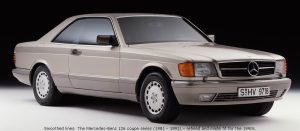
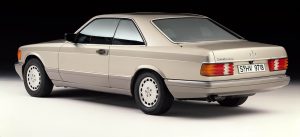


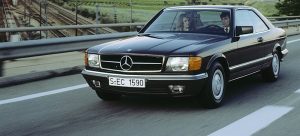
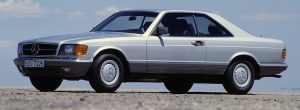
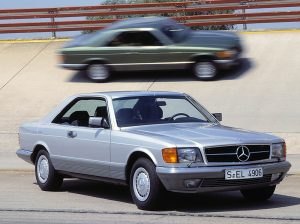
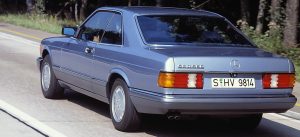
You must be logged in to post a comment.